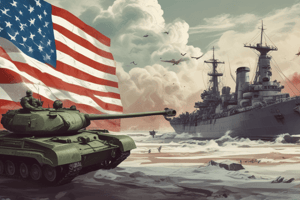Podcast
Questions and Answers
Which of the following best describes the core concept of 'containment' during the Cold War?
Which of the following best describes the core concept of 'containment' during the Cold War?
- Promoting economic interdependence between the Eastern and Western blocs.
- Preventing the spread of communism beyond its existing borders through various means. (correct)
- Actively engaging in direct military conflicts with the Soviet Union to halt its expansion.
- Allowing communist states to expand, provided they adopt democratic reforms.
The Cuban Missile Crisis is considered a pivotal event in the Cold War because it:
The Cuban Missile Crisis is considered a pivotal event in the Cold War because it:
- Forced the United States to abandon its policy of containment.
- Marked the first direct military confrontation between US and Soviet forces.
- Led to the immediate collapse of the Soviet Union's influence in Latin America.
- Brought the world to the brink of nuclear war due to the placement of Soviet missiles in Cuba. (correct)
What was a primary objective of the Marshall Plan, initiated by the United States after World War II?
What was a primary objective of the Marshall Plan, initiated by the United States after World War II?
- To provide economic assistance to Western European countries to help them rebuild and resist communist influence. (correct)
- To promote isolationist policies in Europe to prevent future wars.
- To militarily occupy Eastern Europe and prevent Soviet expansion.
- To establish a global communist network.
Which of the following factors significantly contributed to the end of the Cold War?
Which of the following factors significantly contributed to the end of the Cold War?
What was the primary purpose of the North Atlantic Treaty Organization (NATO) when it was formed in 1949?
What was the primary purpose of the North Atlantic Treaty Organization (NATO) when it was formed in 1949?
How did the launch of Sputnik by the Soviet Union in 1957 impact the Cold War?
How did the launch of Sputnik by the Soviet Union in 1957 impact the Cold War?
Which of the following best characterizes the concept of 'Mutually Assured Destruction' (MAD) during the Cold War?
Which of the following best characterizes the concept of 'Mutually Assured Destruction' (MAD) during the Cold War?
What was the significance of the Berlin Wall, constructed in 1961?
What was the significance of the Berlin Wall, constructed in 1961?
How did the Soviet invasion of Afghanistan in 1979 affect the relationship between the United States and the Soviet Union?
How did the Soviet invasion of Afghanistan in 1979 affect the relationship between the United States and the Soviet Union?
Which of the following policies or events is most closely associated with Ronald Reagan's approach to the Cold War?
Which of the following policies or events is most closely associated with Ronald Reagan's approach to the Cold War?
Flashcards
International Relations (IR)
International Relations (IR)
The study of interactions among states and other actors in the international system, covering diplomacy, war, trade, and human rights.
The Cold War
The Cold War
A period of geopolitical tension between the United States and the Soviet Union and their respective allies from the mid-1940s until 1991.
Containment
Containment
The US policy of preventing the spread of communism abroad during the Cold War.
Deterrence
Deterrence
Signup and view all the flashcards
Mutually Assured Destruction (MAD)
Mutually Assured Destruction (MAD)
Signup and view all the flashcards
Proxy Wars
Proxy Wars
Signup and view all the flashcards
Sphere of Influence
Sphere of Influence
Signup and view all the flashcards
Gorbachev's Reforms
Gorbachev's Reforms
Signup and view all the flashcards
Harry Truman
Harry Truman
Signup and view all the flashcards
Détente (1969-1979)
Détente (1969-1979)
Signup and view all the flashcards
Study Notes
- International Relations (IR) is the study of the interactions among states and other actors in the international system.
- It encompasses a broad range of topics, including diplomacy, war, trade, and human rights.
- The Cold War was a period of geopolitical tension between the United States and the Soviet Union and their respective allies, the Western Bloc and the Eastern Bloc, from the mid-1940s until the dissolution of the Soviet Union in 1991.
Origins of the Cold War
- Conflicting ideologies: The US championed democracy and capitalism, while the Soviet Union promoted communism and a centrally planned economy.
- Post-World War II geopolitical landscape: The war left the US and the Soviet Union as the two dominant superpowers, leading to a power vacuum and competition for influence.
- Mutual distrust: The Soviet Union's expansion into Eastern Europe and the US's development of nuclear weapons fueled suspicion and mistrust on both sides.
- Yalta and Potsdam Conferences: Disagreements over the future of Germany and Eastern Europe at these conferences highlighted the growing divide between the Allies.
Key Events and Developments
- Truman Doctrine (1947): The US pledged to support nations resisting communist expansion, marking a policy of containment.
- Marshall Plan (1948): The US provided economic aid to help rebuild Western Europe, aiming to prevent the spread of communism by fostering economic stability.
- Berlin Blockade (1948-1949): The Soviet Union blocked access to West Berlin, leading the US and its allies to respond with an airlift to supply the city.
- Formation of NATO (1949): The North Atlantic Treaty Organization was established as a military alliance among Western nations to counter Soviet aggression.
- Soviet development of nuclear weapons (1949): This ended the US's nuclear monopoly and escalated the arms race.
- Korean War (1950-1953): A proxy war between the US-backed South Korea and the Soviet/Chinese-backed North Korea heightened Cold War tensions.
- Warsaw Pact (1955): The Soviet Union and its Eastern European allies formed this military alliance in response to NATO.
- Hungarian Revolution (1956): Soviet forces brutally suppressed an uprising in Hungary, demonstrating the limits of Soviet tolerance for dissent in its sphere of influence.
- Sputnik launch (1957): The Soviet Union's successful launch of the first artificial satellite ignited the space race and intensified fears of Soviet technological superiority.
- Cuban Revolution (1959): The communist revolution in Cuba, led by Fidel Castro, brought the Cold War to America's doorstep.
- Berlin Wall construction (1961): The wall physically divided East and West Berlin, becoming a symbol of the Cold War divide.
- Cuban Missile Crisis (1962): The US and the Soviet Union came to the brink of nuclear war after the US discovered Soviet missile sites in Cuba.
- Vietnam War (1955-1975): Another major proxy war, the Vietnam War pitted the US-backed South Vietnam against the communist North Vietnam supported by the Soviet Union and China.
- Détente (1969-1979): A period of easing tensions between the US and the Soviet Union, characterized by arms control agreements and increased diplomacy.
- Soviet invasion of Afghanistan (1979): This invasion ended the period of détente and led to renewed Cold War tensions.
- Strategic Defense Initiative (SDI): Proposed by the Reagan Administration in the early 1980s, the initiative was meant to create a space-based missile defense system.
Key Concepts in Cold War International Relations
- Bipolarity: The international system was dominated by two superpowers, the US and the Soviet Union.
- Containment: The US policy of preventing the spread of communism.
- Deterrence: Discouraging an attack through the threat of retaliation, particularly nuclear retaliation.
- Mutually Assured Destruction (MAD): The doctrine that a full-scale nuclear war would result in the destruction of both attacker and defender.
- Proxy Wars: Conflicts in which the superpowers supported opposing sides without directly engaging each other in combat.
- Ideology: The clash between communist and capitalist ideologies fueled the Cold War.
- Sphere of Influence: Areas where a superpower exerted dominant influence.
The End of the Cold War
- Economic stagnation in the Soviet Union: The Soviet economy struggled to compete with the West.
- Political reforms in the Soviet Union: Mikhail Gorbachev's policies of perestroika (economic restructuring) and glasnost (openness) weakened the communist system.
- Revolutions in Eastern Europe (1989): Communist regimes in Eastern Europe collapsed, leading to the fall of the Berlin Wall.
- Dissolution of the Soviet Union (1991): The Soviet Union broke apart into independent republics, marking the official end of the Cold War.
Consequences of the Cold War
- End of bipolarity: The US became the sole superpower.
- Spread of democracy and capitalism: Many former communist countries transitioned to democratic governments and market economies.
- Increased globalization: The collapse of the Soviet Union led to greater economic and political interconnectedness.
- Regional conflicts: The end of the Cold War led to new conflicts and instability in some regions.
- Nuclear proliferation concerns: Concerns remained about the control and spread of nuclear weapons.
Key Figures
- Harry Truman: US President who implemented the policy of containment.
- Joseph Stalin: Soviet leader during the early Cold War period.
- Nikita Khrushchev: Soviet leader during the Cuban Missile Crisis.
- John F. Kennedy: US President during the Cuban Missile Crisis.
- Mikhail Gorbachev: Soviet leader whose reforms led to the end of the Cold War.
- Ronald Reagan: US President who took a strong stance against the Soviet Union.
Studying That Suits You
Use AI to generate personalized quizzes and flashcards to suit your learning preferences.




